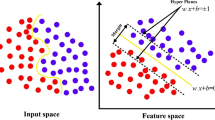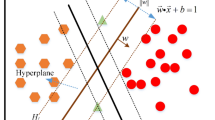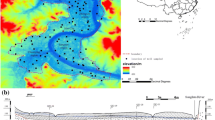Abstract
Mineral exploration modeling can be used to predict locations which exploratory criteria confirm possibility of mineral resources/reserves presence. Due to scientific progresses, existence of a large amount of data and also to prevent personal bias, using of artificial intelligence algorithms is essential. In addition, linear geostatistical techniques will no longer be responsible. Given that dataset has been consisted of geochemical sampling points, multiclass support vector machine algorithm (SVM) is used for mineral prospectivity mapping. SVM is performed with two approaches single and integration it with continuous genetic algorithm (CGASVM) to define hyperparameters of SVM instead of trial and error selection. At the first stage, preprocessing of the data is done and fuzzy factor scores maps are drawn then the anomalies of each factor are determined. After that in order to obtain intelligent modelling, multiclass SVM and CGASVM algorithms are written and implemented in MATLAB; also, to evaluate modelings capability, relevant indicators are used. The achieved results show a high degree of accuracy in classifying test data in both exploratory modellings compared to traditional methods that are also consistent with field studies. These methods can be used to intelligently explore minerals and subsequently to determine mineralization zones. The abovementioned algorithms are applied to avoid consuming time and labor and where the result of sampling cannot be determined directly.









Similar content being viewed by others
References
Abbasi H, Ardabili S, Mahdi S, Amin MM, Zahra E-D (2015) Comparison of trial and error and genetic algorithm in neural network development for estimating farinograph properties of wheat-flour dough. Nutrition and food sciences research 2:29–38
Abbaszadeh M, Ardeshir H, Saeed S-M (2013) An SVM-based machine learning method for the separation of alteration zones in Sungun porphyry copper deposit. Geochemistry 73:545–554
Acar MC, Kaya B (2020) Models to estimate the elastic modulus of weak rocks based on least square support vector machine. Arab J Geosci 13. https://doi.org/10.1007/s12517-020-05566-6
Battineni G, Chintalapudi N, Amenta F (2019) Machine learning in medicine: performance calculation of dementia prediction by support vector machines (SVM). https://doi.org/10.1016/j.imu.2019.100200
Buat-Menard RA, Chesselet R (1979) Variable influence of the atmospheric flux on the trace metal chemistry of oceanic suspended matter. J Earth Planet Sci Lett 42:398–411
Ccoicca Y (2013) Applications of support vector machines in the exploratory phase of petroleum and natural gas: a survey. International Journal of Engineering and Technology 2:113–125
Ceryan N (2014) Application of support vector machines and relevance vector machines in predicting uniaxial compressive strength of volcanic rocks. J Afr Earth Sci 100:634–644
Chen Y, Wu W (2017) Application of one-class support vector machine to quickly identify multivariate anomalies from geochemical exploration data. Geochemistry: Exploration, Environment, Analysis 17:231–238
Colkesen I, Emrehan KS, Taskin K (2016) Susceptibility mapping of shallow landslides using kernel based gaussian process, support vector machines and logistic Regression. J Afr Earth Sci 118:53–64
De Jong KA (1975) Analysis of the behavior of a class of genetic adaptive systems. Ph.D. Dissertation. University of Michigan, Ann Arbor
Ebrahimyzade A, Fakhrzad MB (2013) A dynamic genetic algorithm for solving a single machine scheduling problem with periodic maintenance. Hindawi publishing corporation 2013:1–11. https://doi.org/10.1155/2013/936814
Ghannadpour S, Hezarkhani A (2020) Mineral potential mapping for Au and as using Gap statistic method in multivariate mode. Carbonates Evaporites 35. https://doi.org/10.1007/s13146-019-00546-8
Goldberg DE (1989) Genetic algorithms in search, optimization, and machine learning. Addison-Wesley, Reading, MA
Granek J (2016) Application of machine learning algorithms to mineral prospectivity mapping. University of British Columbia, Dissertation
Granek J, Haber E (2016) Advanced geoscience targeting via focused machine learning applied to the Quest project dataset, British Columbia. Geoscience BC 2016-1:117–126
Grunsky EC (2010) The interpretation of geochemical survey data. Geochemistry Exploration Environment Analysis 10(1):27–74
Grunsky E. C., Caritat P. de (2020) State-of-the-art analysis of geochemical data for mineral exploration. Geochemistry: Exploration, Environment, Analysis 20(2): 217–232.
Haupt Randy L., Haupt, Sue Ellen (2004) Practical genetic algorithms. A John Wiley &Sons, INC., publication.
Kandel I, Castelli M (2020) The effect of batch size on the generalizability of the convolutional neural networks on a histopathology dataset. ICT Express 6:312–315. https://doi.org/10.1016/j.icte.2020.04.010
Kuchin Y, Grundspenkis J (2017) Machine learning methods for identifying composition of uranium deposits in Kazakhstan. Applied computer systems 22:21–27
Ma G, Zhiming C, Ye Z, Zhu Y, Hu H (2018) The application of support vector machine in geotechnical engineering. International conference on Civil and Hydraulic Engineering 1:1–6
Manurung J, Herman M, Elviawaty Z (2017) Optimizing support vector machine parameters with genetic algorithm for credit risk assessment. J Phys 930:012026. https://doi.org/10.1088/1742-6596/930/1/012026
Masoud AA, El-Horiny MM, Atwia MG, Gemail KS, Katsuaki K (2018) Assessment of groundwater and soil quality degradation using multivariate and geostatistical analyses, Dakhla Oasis, Egypt. J Afr Earth Sci 142:64–81
Miesch AT (1967) Methods of computation for estimating geochemical abundance. United States government printing office Washington.
O'Shea Keiron Teilo, Nash Ryan (2015) An Introduction to Convolutional Neural Networks. https://arxiv.org/abs/1511.08458.
Peng Y, Kou G, Shi Y, Chen ZX (2008) A descriptive framework for the field of data mining and knowledge discovery. Int J Inf Technol Decis Mak 7(4):639–682. https://doi.org/10.1142/S0219622008003204
Perkins JL, Cutter GN, Cleveland MS (1990) Estimating the mean, variance and confidence limit from censored (<limit of detection), lognormally-distributed exposure data. Am Ind Hyg Assoc J 51(8):416–419
Reimann C, Peter F, Garrett RG (2002) Factor analysis applied to regional geochemical data: problems and possibilities. Appl Geochem 17:185–206
Sanford RF, Pierson CT, Crovelli RA (1993) An objective replacement method forcensored geochemical data. Math Geol 25:59–80
Shahrestani S, Mokhtari AR (2017) Dilution correction equation revisited: The impact of stream slope, relief ratio and area size of basin on geochemical anomalies. J Afr Earth Sci 128:16–26
Tahmooresi Mandana, 2021, Data mining and intelligent optimization of support vector machine and convolutional neural network using genetic algorithm in order to modeling for mineral potential exploration (Case study: Gonabad arena), Ph.D. Dissertation, Mahallat Branch, Islamic Azad University, Mahallat, IRAN. (Note: under review).
Tawo EE, Al-Alawi SM (1999) A comparison between artificial neural network and a geostatistical technique in the estimation of regionalize variables, Engineering. Journal of the University of Qatar 12:125–149
Tikhamarine Y, Doudja S-G, Ozgur K (2019) A new intelligent method for monthly stream flow prediction: hybrid wavelet support vector regression based on grey wolf optimizer (WSVR–GWO). Arab J Geosci 12. https://doi.org/10.1007/s12517-019-4697-1
Yang Q, Wu XD (2006) 10 challenging problems in data mining research. Int J Inf Technol Decis Mak 5(4):567–604. https://doi.org/10.1142/S0219622006002258
Zuo R, Carranza E, John M (2011) Support vector machine: A tool for mapping mineral prospectivity. Comput Geosci. https://doi.org/10.1016/j.cageo.2010.09.014
Acknowledgements
The authors would like to thank Mr.Vajiollah Jafari CEO of Iran minerals production and supply company for constructive comments and suggestions.
Also, the authors would like to express their gratitude to Dr. Feridon Ghadimi assistant professor, department of mining engineering, Arak University of Technology, for reviewing the manuscript and providing helpful comments.
This article is the results section of the research related to Miss Mandana Tahmooresi’s dissertation that has been done in Mahallat Branch, Islamic Azad University.
Author information
Authors and Affiliations
Corresponding author
Ethics declarations
Conflict of interest
The author(s) declare that they have no competing interests.
Additional information
Responsible Editor: Domenico M. Doronzo
Supplementary Material
ESM 1
(XLSX 741 kb)
Rights and permissions
About this article
Cite this article
Tahmooresi, M., Babaei, B. & Dehghan, S. Intelligent geochemical exploration modeling using multiclass support vector machine and integration it with continuous genetic algorithm in Gonabad region, Khorasan Razavi, Iran. Arab J Geosci 14, 1012 (2021). https://doi.org/10.1007/s12517-021-07306-w
Received:
Accepted:
Published:
DOI: https://doi.org/10.1007/s12517-021-07306-w




